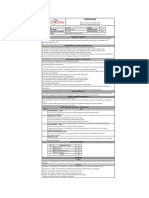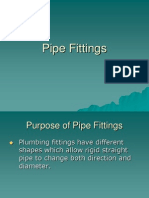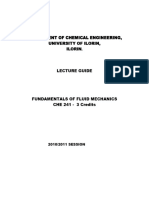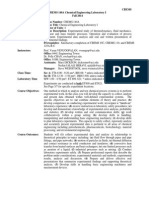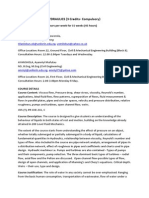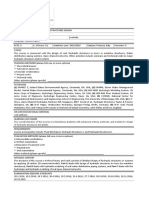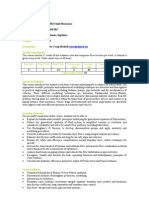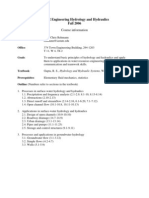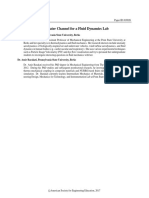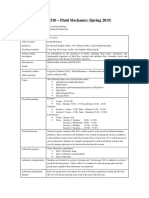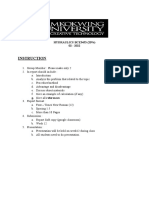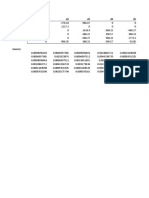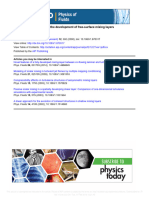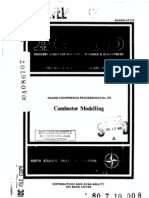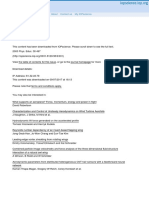0 ratings0% found this document useful (0 votes)
167 viewsHydraulics
Hydraulics
Uploaded by
Yuoyung tin1) This document is a course syllabus for a Hydraulics Engineering course offered at the Technological Institute of the Philippines.
2) The course covers topics such as closed conduit flow, open channel flow, pipe networks, pumps, turbines, dams, and hydraulic structures.
3) The goals of the course are for students to develop theoretical and analytical skills in hydraulics engineering and be able to solve problems and design hydraulic structures.
Copyright:
© All Rights Reserved
Available Formats
Download as PDF, TXT or read online from Scribd
Hydraulics
Hydraulics
Uploaded by
Yuoyung tin0 ratings0% found this document useful (0 votes)
167 views2 pages1) This document is a course syllabus for a Hydraulics Engineering course offered at the Technological Institute of the Philippines.
2) The course covers topics such as closed conduit flow, open channel flow, pipe networks, pumps, turbines, dams, and hydraulic structures.
3) The goals of the course are for students to develop theoretical and analytical skills in hydraulics engineering and be able to solve problems and design hydraulic structures.
Original Description:
Hydraulics
Copyright
© © All Rights Reserved
Available Formats
PDF, TXT or read online from Scribd
Share this document
Did you find this document useful?
Is this content inappropriate?
1) This document is a course syllabus for a Hydraulics Engineering course offered at the Technological Institute of the Philippines.
2) The course covers topics such as closed conduit flow, open channel flow, pipe networks, pumps, turbines, dams, and hydraulic structures.
3) The goals of the course are for students to develop theoretical and analytical skills in hydraulics engineering and be able to solve problems and design hydraulic structures.
Copyright:
© All Rights Reserved
Available Formats
Download as PDF, TXT or read online from Scribd
Download as pdf or txt
0 ratings0% found this document useful (0 votes)
167 views2 pagesHydraulics
Hydraulics
Uploaded by
Yuoyung tin1) This document is a course syllabus for a Hydraulics Engineering course offered at the Technological Institute of the Philippines.
2) The course covers topics such as closed conduit flow, open channel flow, pipe networks, pumps, turbines, dams, and hydraulic structures.
3) The goals of the course are for students to develop theoretical and analytical skills in hydraulics engineering and be able to solve problems and design hydraulic structures.
Copyright:
© All Rights Reserved
Available Formats
Download as PDF, TXT or read online from Scribd
Download as pdf or txt
You are on page 1of 2
T I P - V P A A - 0 0 1
Revision Status/Date: 3/2016 Oct 28
TECHNOLOGICAL INSTITUTE OF THE PHILIPPINES
COURSE SYLLABUS
COURSE CODE CE 411 Hydraulics Engineering (2012 Curriculum)
COURSE NAME CE 483L1 Hydraulics Engineering (2010 Curriculum)
CE 483L1 Hydraulics Engineering (2003 Curriculum)
CREDITS 4 units (3 units lecture, 1 unit laboratory)
CONTACT HOURS 3 hours’ lecture, 3 hours’ laboratory
Engr. John Pepard M. Rinchon
INSTRUCTOR
Faculty Member of Civil Engineering Department
Cruise, J. F., Sherif, M. M., & Singh, V. P. (2012). Introduction to
TEXTBOOK
Hydraulics. Cengage Learning Asia Pte Ltd.
Other Supplemental Nalluri, C. (2001). Civil Engineering Hydraulics: Essential Theory
Materials with Worked Examples. Australia: Blackwell Science.
Chadwick, A. (2004). Hydraulics in Civil and Environmental
Engineering. London: Spon Press.
SPECIFIC COURSE INFORMATION
a. Course Description
The course deals with the study of hydraulic analysis and design and its application to hydraulics
structures such pipe network, pump, turbine, tank, reservoir, dam, spillway, levee, weir, flood gate,
open channel, among others. Specifically, it discusses the: different flow phenomena; conservation
laws governing in closed conduit flow, surcharge flow, and free surface flow (open channel); energy
loss due to friction and minor constrictions (bend, fittings, etc.) of closed conduit flow; flow resistance
due to friction of free surface flow; design procedures of hydraulics and flood control structures. It
also deals with scouring and erosion control and hydraulic modeling.
b. Prerequisites CE 402
Co-requisites None
c. Course Classification
(Required/ Elective/ Required
Selected Elective)
SPECIFIC GOALS FOR THE COURSE
a. Course Objective(s)
The course aims to develop the following:
1. Demonstrate theoretical and analytic hydraulics knowledge and skills.
2. Solve problems relevant to the study of hydraulics engineering.
3. Utilize skills in the analysis and design of hydraulics engineering structures.
b. Course Intended Learning Outcome(s) CILOs
At the end of the course, students should be able to:
1. Discuss the basic fluid mechanics and hydraulic engineering theories.
2. Function effectively as a team member in developing a small-scale hydraulics engineering
project.
3. Solve problems in closed conduit and free surface flows based on the principles of
hydrostatics, hydrodynamics and governing conservation laws and its application to
hydraulics engineering structures.
4. Design an effective and efficient hydraulic structure.
c. Student Outcome(s) Addressed by the Course
Students will be able to:
1. Design and conduct experiments, as well as to analyze, and interpret data, and synthesize
information to provide valid conclusions for investigating complex problems. (SO d)
2. Function effectively as an individual, and as a member or leader in diverse teams and in
multidisciplinary settings. (SO i)
COURSE TOPICS
Prelim Period (Weeks 1–6)
I. Introduction. TIP Vision and Mission; TIP Graduate Attributes/ Institutional Intended
Learning Outcomes; Program Objectives/ Program Educational Objectives / Student
Outcomes/ Course Objectives/Course Intended Learning Outcomes; Course Policies.
II. Review of Fluid Mechanics: Properties of Fluid; Classification of Fluid; Flow Classification
(Uniform, Non-uniform, Steady, Unsteady, Laminar, Turbulent); Application of Control
Volume in view of Hydraulics Engineering; Boundary layer and No Slip Condition.
III. Introduction to Closed Conduit and Surcharge Flows; Governing Conservation Laws (Mass,
Energy and Momentum) in Closed Conduit Flow; Principle of Energy Grade Line (EGL) and
Hydraulic Grade Line (HGL); Different Discharge Measurements; Major and Minor Energy
Head Losses in Pipes; Application of Pumps and Turbines in Pipelines; Pipe Connections
(Series and Parallel); Pipe Network; Introduction of EPANet; Three Reservoirs Problem;
Water Hammer and Surges in Pipes.
Midterm Period (Weeks 7–12)
IV. Introduction to Free Surface Flow (Open Channel); Channel Geometry and Channel
Efficiency (Most Efficient Section); Governing Laws in Free Surface Flow (Mass, Energy and
Momentum); Flow Resistance in Open Channels; Principle of EGL and Depth-Specific
Energy Diagram; Discharge Measurement in Open Channel; Free Surface Flow Stages (Sub
Critical, Critical, Super Critical); Hydraulic Jump; Gradually and Rapid Varied Flows.
Final Period (Weeks 13–18)
V. Computation of Water Surface Profile (Numerical Integration Method, Direct Step Method,
and Standard Step Method); Introduction of HEC-RAS;
VI. Basic Principles: a) Design of Water Supply and Distribution Systems; b) Hydraulic Drainage
and Control Structures.
Prepared by: Noted by: Approved to take effect on ___Sem___SY
______________________________________ ___________________ __________________________________
Faculty Member’s Printed Name and Signature Department Chair Dean/VPAA
Date: Date: Date:
You might also like
- Course Outline - DJJ2093 - Latest PDFDocument1 pageCourse Outline - DJJ2093 - Latest PDFThaneswaran BaluNo ratings yet
- Pipe FittingsDocument32 pagesPipe Fittingsalinor_tn100% (5)
- Plants: Manual of Practice No.11. Vol. Management and Support Systems. New York: Mcgraw HillDocument2 pagesPlants: Manual of Practice No.11. Vol. Management and Support Systems. New York: Mcgraw HillalyssaNo ratings yet
- CVNG 2005 May 2009 Shrivastava and Chadwick ModifiedDocument2 pagesCVNG 2005 May 2009 Shrivastava and Chadwick Modifiedrajal11No ratings yet
- SKAA 2513 - Cource OutlineDocument7 pagesSKAA 2513 - Cource OutlineRofanddi RahmadNo ratings yet
- Abe 517Document6 pagesAbe 517KEHINDE BABALOLANo ratings yet
- Che 241 Lecturer NoteDocument85 pagesChe 241 Lecturer Noteredni907No ratings yet
- Ecw 321Document8 pagesEcw 321ajanlahhNo ratings yet
- Cbems 140aDocument19 pagesCbems 140amdawg467No ratings yet
- CVE334 CoursewareDocument5 pagesCVE334 CoursewareSamuelShinaAyodeleNo ratings yet
- Universiti Malaysia Perlis: Borang Penawaran Kursus BaruDocument5 pagesUniversiti Malaysia Perlis: Borang Penawaran Kursus Barukhai9000No ratings yet
- Chapter 1 IntroductionDocument27 pagesChapter 1 IntroductionKit Meng LimNo ratings yet
- 9269 Laboratori Od I ProDocument2 pages9269 Laboratori Od I ProMamuye Busier YesufNo ratings yet
- 1 Introduction Lecture CRUDocument18 pages1 Introduction Lecture CRUkelvinmsemo33No ratings yet
- Introduction To FluidmechanicsDocument28 pagesIntroduction To FluidmechanicsSomnath SwamyNo ratings yet
- 3B2Document2 pages3B2imanadibiNo ratings yet
- ME 311-Fluid MechanicsDocument2 pagesME 311-Fluid Mechanicssaeed al-zahraniNo ratings yet
- HHM Handout (2019-20)Document24 pagesHHM Handout (2019-20)Arun ChaitanyaNo ratings yet
- Department of Civil Engineering: Course Structure and Syllabus (1 - 4 Semester) FOR M. Tech ProgrammeDocument41 pagesDepartment of Civil Engineering: Course Structure and Syllabus (1 - 4 Semester) FOR M. Tech ProgrammeVishal NaikNo ratings yet
- Ce8302 FM PresentationDocument102 pagesCe8302 FM PresentationRON SAMUEL 401935100% (1)
- Gujarat Technological University: Semester - III Subject NameDocument3 pagesGujarat Technological University: Semester - III Subject NameshyamNo ratings yet
- CE74.12: Hydrodynamics 3 (3-0) Course Objectives:: School of Engineering and Technology, (SET)Document3 pagesCE74.12: Hydrodynamics 3 (3-0) Course Objectives:: School of Engineering and Technology, (SET)Danna ValdezNo ratings yet
- Course Outline AASTU - 2021Document3 pagesCourse Outline AASTU - 2021Adnan ShafiNo ratings yet
- HydraulicsDocument7 pagesHydraulicsBernard PalmerNo ratings yet
- HydraulicsDocument87 pagesHydraulicsNAAC CivilNo ratings yet
- CE 303-HydraulicsDocument4 pagesCE 303-HydraulicsfefahimNo ratings yet
- FMM LAB MANUALSDocument85 pagesFMM LAB MANUALSrd233295No ratings yet
- CHEN 311 Syllabus Fall 2015Document3 pagesCHEN 311 Syllabus Fall 2015Amy MillerNo ratings yet
- Department of Civil Engineering: 2015-2016 Hydraulics and Hydraulic Machinery Course FileDocument178 pagesDepartment of Civil Engineering: 2015-2016 Hydraulics and Hydraulic Machinery Course Filerajashekar309No ratings yet
- 6th Sem CE SyllabusDocument10 pages6th Sem CE SyllabusAmenul HoqueNo ratings yet
- Universiti Tun Hussein Onn Malaysia: Open Ended Laboratory InstructionsDocument15 pagesUniversiti Tun Hussein Onn Malaysia: Open Ended Laboratory InstructionsArif AfifiNo ratings yet
- CE6451 SCAD MSM by WWW - Learnengineering.inDocument166 pagesCE6451 SCAD MSM by WWW - Learnengineering.intech guyNo ratings yet
- English 2013218183723Document5 pagesEnglish 2013218183723Obumneke NwaoshoNo ratings yet
- New OECsDocument36 pagesNew OECsrajamar2119No ratings yet
- Fundamentals of Hydraulic Engineering by Prasuhn, Alan L.Document325 pagesFundamentals of Hydraulic Engineering by Prasuhn, Alan L.Anonymous zwnFXURJNo ratings yet
- Design and Build A Water Channel For A Fluid Dynamics LabDocument10 pagesDesign and Build A Water Channel For A Fluid Dynamics Labsampath kumar K NNo ratings yet
- 6th Sem SyllabusDocument24 pages6th Sem SyllabusVikrant DekaNo ratings yet
- ABET Hydrology SyllabusDocument4 pagesABET Hydrology Syllabuselnaqa176No ratings yet
- Open Ended Hydraulics Laboratory PDFDocument15 pagesOpen Ended Hydraulics Laboratory PDFCx YuNgNo ratings yet
- CIVL 2510 - Course SyllabusDocument3 pagesCIVL 2510 - Course SyllabuswilsonNo ratings yet
- Civ 208Document17 pagesCiv 208SanthoshMBSanthuNo ratings yet
- Engineering Fluid Mechanics Information and IntroductionDocument17 pagesEngineering Fluid Mechanics Information and Introductionmavimu_20No ratings yet
- 3ME05 Fluid Mechanics: Course Learning ObjectivesDocument3 pages3ME05 Fluid Mechanics: Course Learning Objectivesgotu123No ratings yet
- B-Spline Ocean CirculationDocument25 pagesB-Spline Ocean CirculationThái Thanh PhanNo ratings yet
- Witwil RefDocument26 pagesWitwil RefSrinivas KanakalaNo ratings yet
- FM Lab 17mel57 MannualDocument43 pagesFM Lab 17mel57 MannualChandan GowdaNo ratings yet
- WRE 404 Lab - Lec1 To Lec6Document22 pagesWRE 404 Lab - Lec1 To Lec6ShahAfzalSakiNo ratings yet
- B.tech FM Course PlanDocument8 pagesB.tech FM Course PlanAnonymous e9EIwbUY9No ratings yet
- II.B.Tech-Civil-II Sem1 (Syllabus, Courses Structure & Lesson Plans) 2018-19 (24-11-18)Document46 pagesII.B.Tech-Civil-II Sem1 (Syllabus, Courses Structure & Lesson Plans) 2018-19 (24-11-18)Krishnapriya KNo ratings yet
- Syllabus Fy CHARUSATDocument95 pagesSyllabus Fy CHARUSATVrajesh ShahNo ratings yet
- Civil III IsemDocument10 pagesCivil III IsemSyed ZubairNo ratings yet
- National University of Engineering College of Geological, Mining and Metallurgical Engineering Metallurgical Engineering ProgramDocument3 pagesNational University of Engineering College of Geological, Mining and Metallurgical Engineering Metallurgical Engineering ProgramJhair JhamidhNo ratings yet
- WW TP OutlineDocument26 pagesWW TP Outlineqber2000No ratings yet
- CIV-0951561-Hydraulic Structure-Feb-2017-Spring PDFDocument2 pagesCIV-0951561-Hydraulic Structure-Feb-2017-Spring PDFMohamed Al-OdatNo ratings yet
- Hydraulics Bce3453 (02-2022)Document3 pagesHydraulics Bce3453 (02-2022)NANTHINI A/P VIJEYAN / UPMNo ratings yet
- Fakulti Kejuruteraan Universiti Malaysia Sarawak SESI 2-2008/2009 Course PlanDocument3 pagesFakulti Kejuruteraan Universiti Malaysia Sarawak SESI 2-2008/2009 Course PlanOng George SammyNo ratings yet
- University of Engineering and Technology Lahore: Department: Civil Engineering Section Course Outline ReportDocument2 pagesUniversity of Engineering and Technology Lahore: Department: Civil Engineering Section Course Outline ReportEngr.Hamid Ismail CheemaNo ratings yet
- SynopsisDocument9 pagesSynopsisUtkarsh VashishthaNo ratings yet
- Me (Wre&gis)Document15 pagesMe (Wre&gis)Mohamed Nageeb SalemNo ratings yet
- Mnemonics PDFDocument5 pagesMnemonics PDFYuoyung tinNo ratings yet
- Equations: d1 d2 d3 d4 d5Document2 pagesEquations: d1 d2 d3 d4 d5Yuoyung tinNo ratings yet
- Value Engineering Approach in The Underpass Projects in Iran: A Case Study in Gachsaran Underpass ProjectDocument13 pagesValue Engineering Approach in The Underpass Projects in Iran: A Case Study in Gachsaran Underpass ProjectYuoyung tinNo ratings yet
- CRPC Pavement Design PDFDocument20 pagesCRPC Pavement Design PDFYuoyung tinNo ratings yet
- National Guidelines Volume 2Document104 pagesNational Guidelines Volume 2Yuoyung tinNo ratings yet
- Simplified Static Force ProcedureDocument10 pagesSimplified Static Force ProcedureYuoyung tinNo ratings yet
- Earthquake EngineeringDocument24 pagesEarthquake EngineeringYuoyung tin100% (1)
- 04 Precipitation PDFDocument42 pages04 Precipitation PDFYuoyung tin0% (1)
- Hydrology 6 Hydrology 6 Hydrology 6: SB F WT Subsurface WaterDocument41 pagesHydrology 6 Hydrology 6 Hydrology 6: SB F WT Subsurface WaterYuoyung tinNo ratings yet
- DensityDocument2 pagesDensitymnl4602No ratings yet
- Steps For Design of Heat ExchangerDocument11 pagesSteps For Design of Heat ExchangerAqil GhaffarNo ratings yet
- Fluid Mechanics-I (CE-219)Document11 pagesFluid Mechanics-I (CE-219)SherazNo ratings yet
- Tshoga Lo PDFDocument11 pagesTshoga Lo PDFlehlabileNo ratings yet
- ME 305 Part 4 Integral Formulation of Fluid FlowDocument39 pagesME 305 Part 4 Integral Formulation of Fluid FlowArlindo Lopes FariaNo ratings yet
- Pumps BEHREN ManualsDocument3 pagesPumps BEHREN Manualsboris345678No ratings yet
- Balac Srdan MSC 2019Document80 pagesBalac Srdan MSC 2019Naufal SatiNo ratings yet
- Materi Pengenalan Pengoperasian Dan Perawatan Fire PumpDocument48 pagesMateri Pengenalan Pengoperasian Dan Perawatan Fire PumpBALLYNo ratings yet
- Chap 17 LectureDocument47 pagesChap 17 LecturesureshbabuNo ratings yet
- Week5 Analysis of Pipe NetworksDocument16 pagesWeek5 Analysis of Pipe Networkselif sNo ratings yet
- Journal of EEA, Vol. 28, 2011: Keywords: Centrifugal Pump, FLUENTDocument7 pagesJournal of EEA, Vol. 28, 2011: Keywords: Centrifugal Pump, FLUENTMohammed El-ShahatNo ratings yet
- Effects of Shallowness On The Development of Free-Surface Mixing LayersDocument12 pagesEffects of Shallowness On The Development of Free-Surface Mixing LayersWilly the WillNo ratings yet
- The Secret of Hydraulic Schematics-1-10Document10 pagesThe Secret of Hydraulic Schematics-1-10Erik Santiago100% (1)
- Combustor ModellingDocument388 pagesCombustor ModellingLeela PrasadNo ratings yet
- 1007 DISQ 0 J SS 33030 Control Valve SpecificationDocument18 pages1007 DISQ 0 J SS 33030 Control Valve Specificationeng20072007No ratings yet
- Chapter3 Specific EnergyDocument31 pagesChapter3 Specific EnergyMuhammad Arya WisesaNo ratings yet
- Process & Instrumentation Diagram (P&ID) : Dr. RameshDocument66 pagesProcess & Instrumentation Diagram (P&ID) : Dr. Rameshalejandro inostrozaNo ratings yet
- Department of Civil Engineering: Term PaperDocument29 pagesDepartment of Civil Engineering: Term PaperMD. TANVIR ANJUM JIMNo ratings yet
- LESSON 3 - ManometerDocument7 pagesLESSON 3 - ManometerPamela MendozaNo ratings yet
- Scheme of Examination and Syllabus For B.Tech (Civil Engineering)Document57 pagesScheme of Examination and Syllabus For B.Tech (Civil Engineering)हुडदंग हास्य कवि सम्मलेनNo ratings yet
- Verification and Validation in Computational Science and 52t7f4iqq8Document7 pagesVerification and Validation in Computational Science and 52t7f4iqq8Lisbeth VilNo ratings yet
- Holger Babinsky 2003 Phys. Educ. 38 001Document8 pagesHolger Babinsky 2003 Phys. Educ. 38 001batanejaNo ratings yet
- Unsteady Flow of A Viscous Fluid Over Plane Wall: Erdo An, MDocument8 pagesUnsteady Flow of A Viscous Fluid Over Plane Wall: Erdo An, MSrinivas JangiliNo ratings yet
- Comparisons Between Measurements in Regions of LamDocument58 pagesComparisons Between Measurements in Regions of LamNeoNo ratings yet
- Single Phase Flow Pressure Drop Analysis in A Plate Heat ExchangerDocument10 pagesSingle Phase Flow Pressure Drop Analysis in A Plate Heat ExchangerElvis AnsuNo ratings yet
- Bombas HALE SCI PDFDocument190 pagesBombas HALE SCI PDFRonny Estremadoiro ArteagaNo ratings yet
- CLS Aipmt 15 16 XI Che Study Package 2 SET 1 Chapter 5Document20 pagesCLS Aipmt 15 16 XI Che Study Package 2 SET 1 Chapter 5sairaj67% (3)
- 2006 - Vacuum in Accelerators - Platja Daro - SpainDocument416 pages2006 - Vacuum in Accelerators - Platja Daro - SpainAfzaal AshrafNo ratings yet
